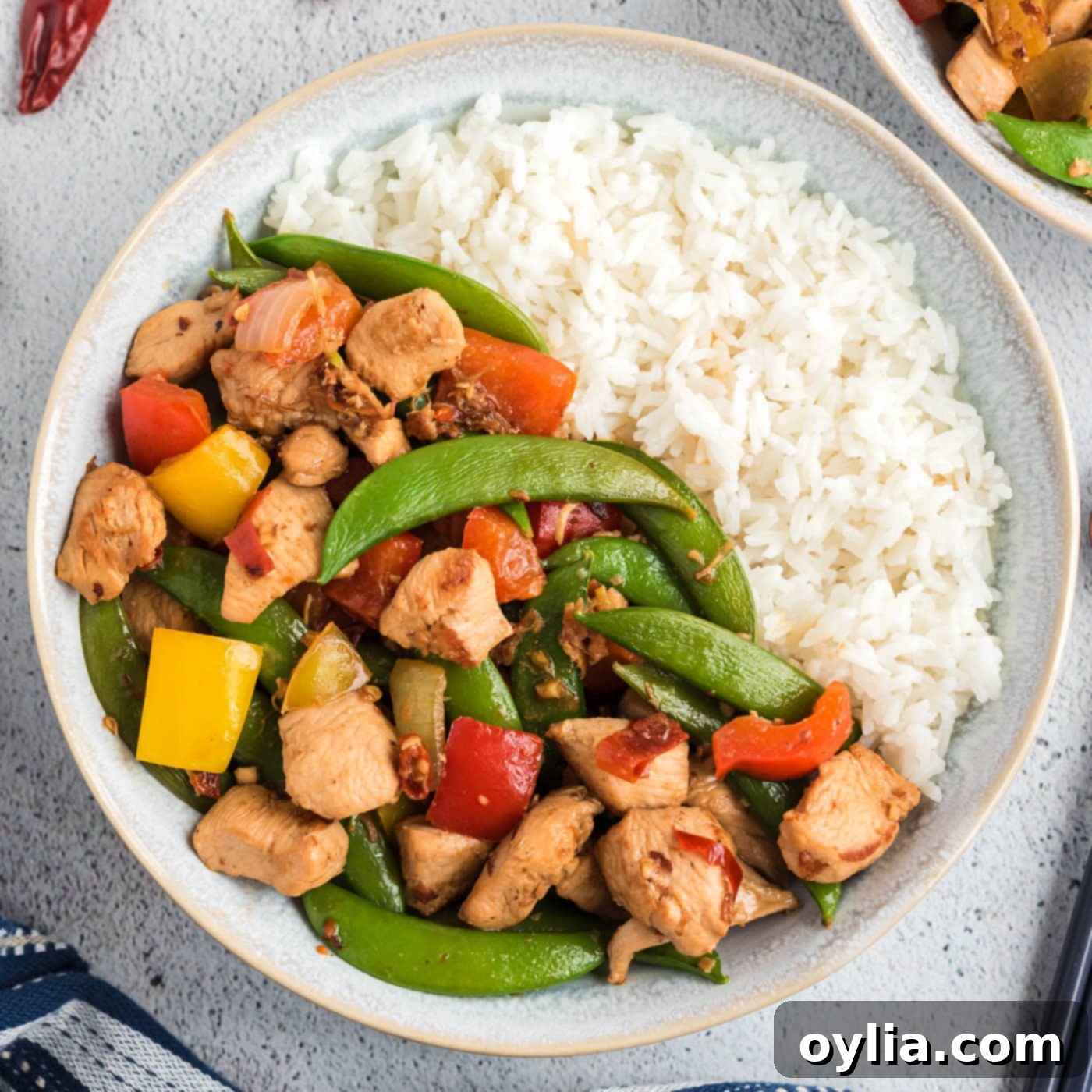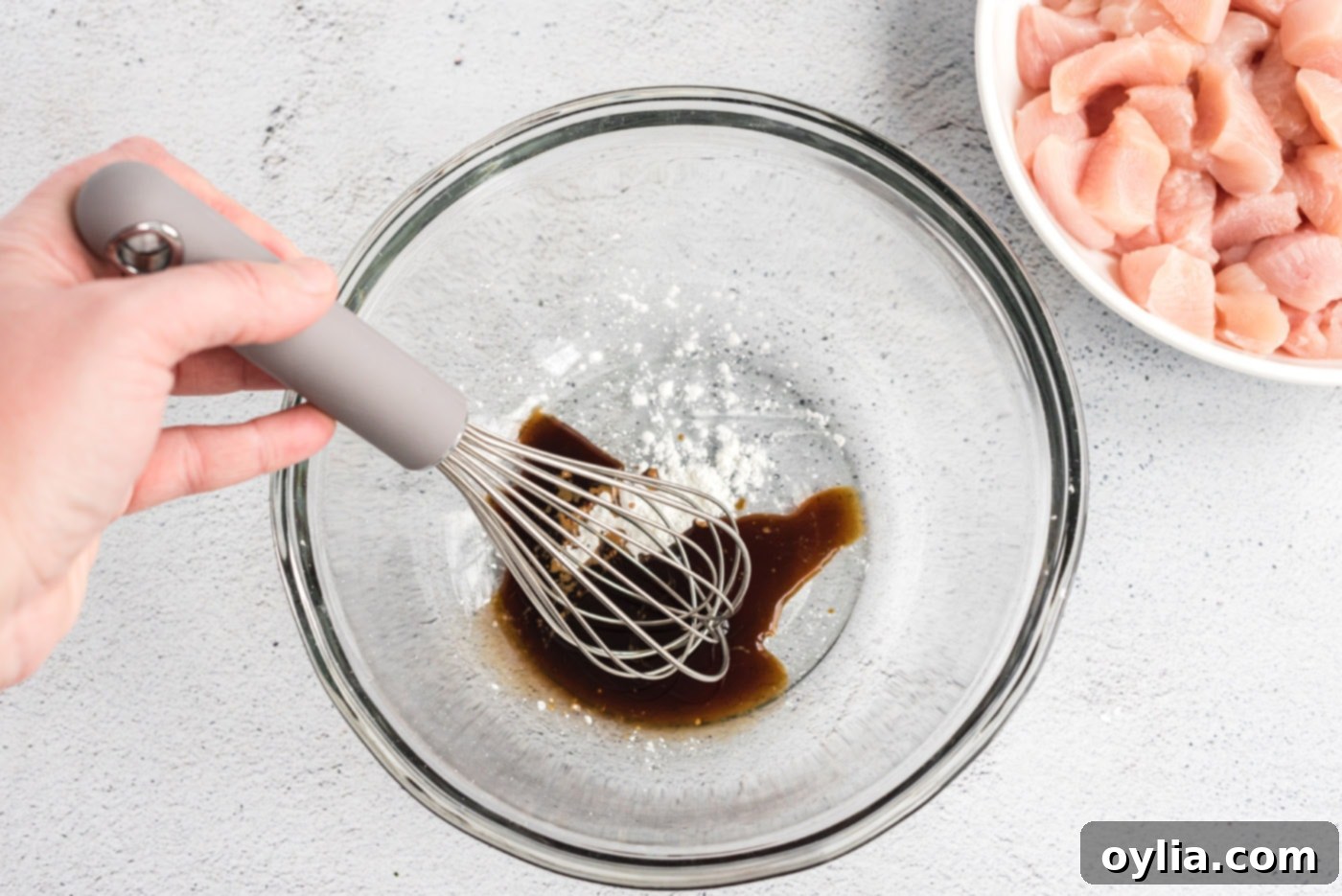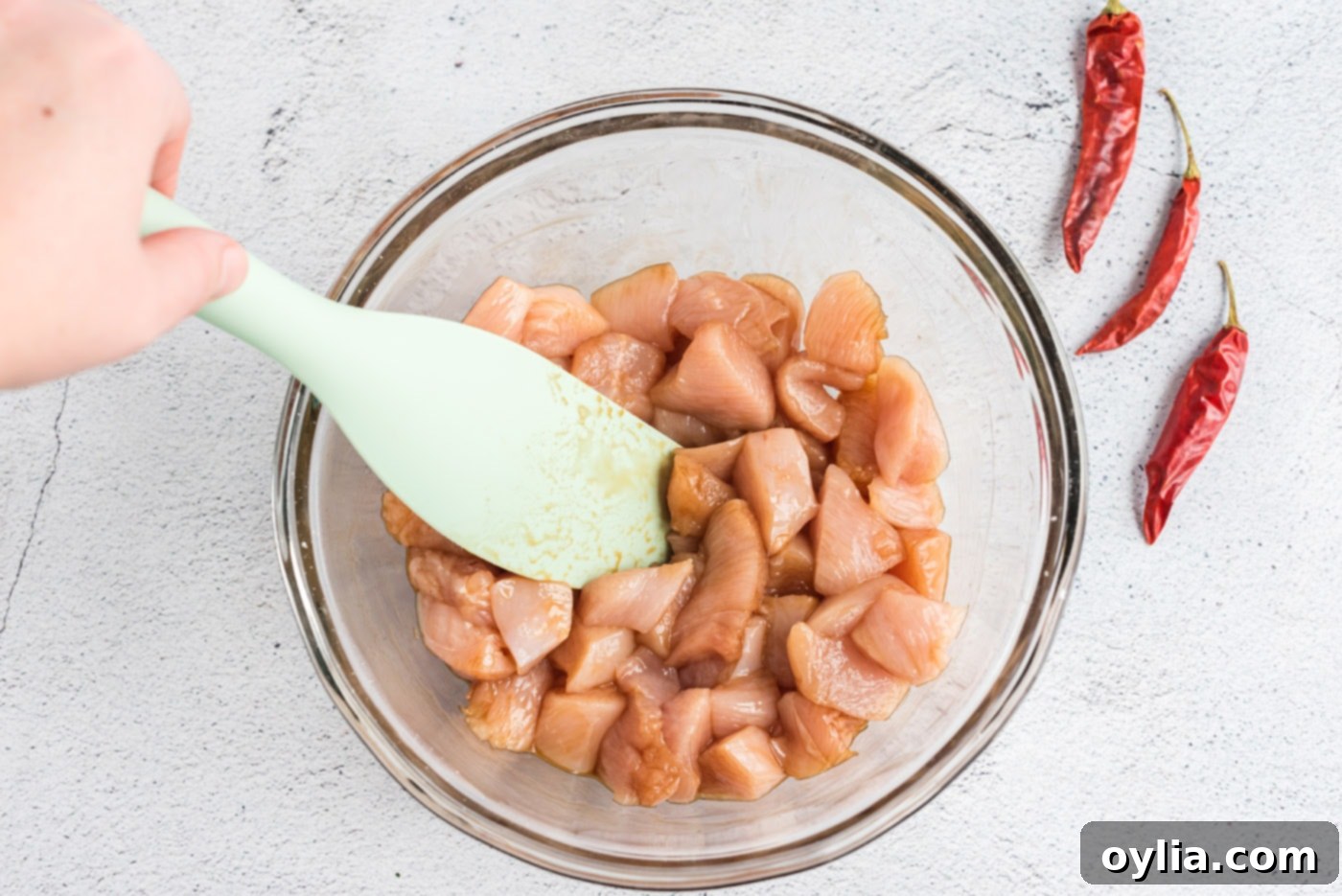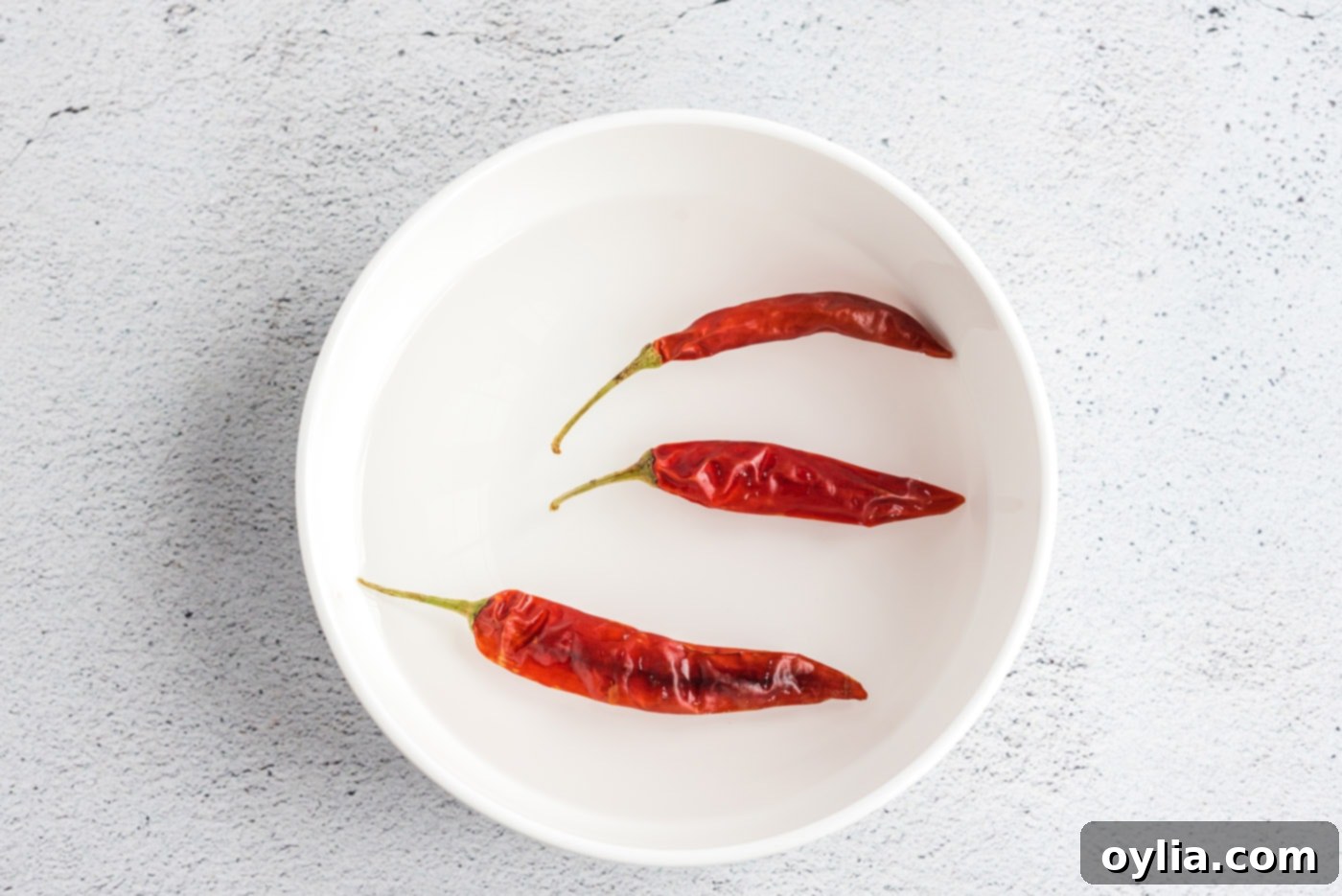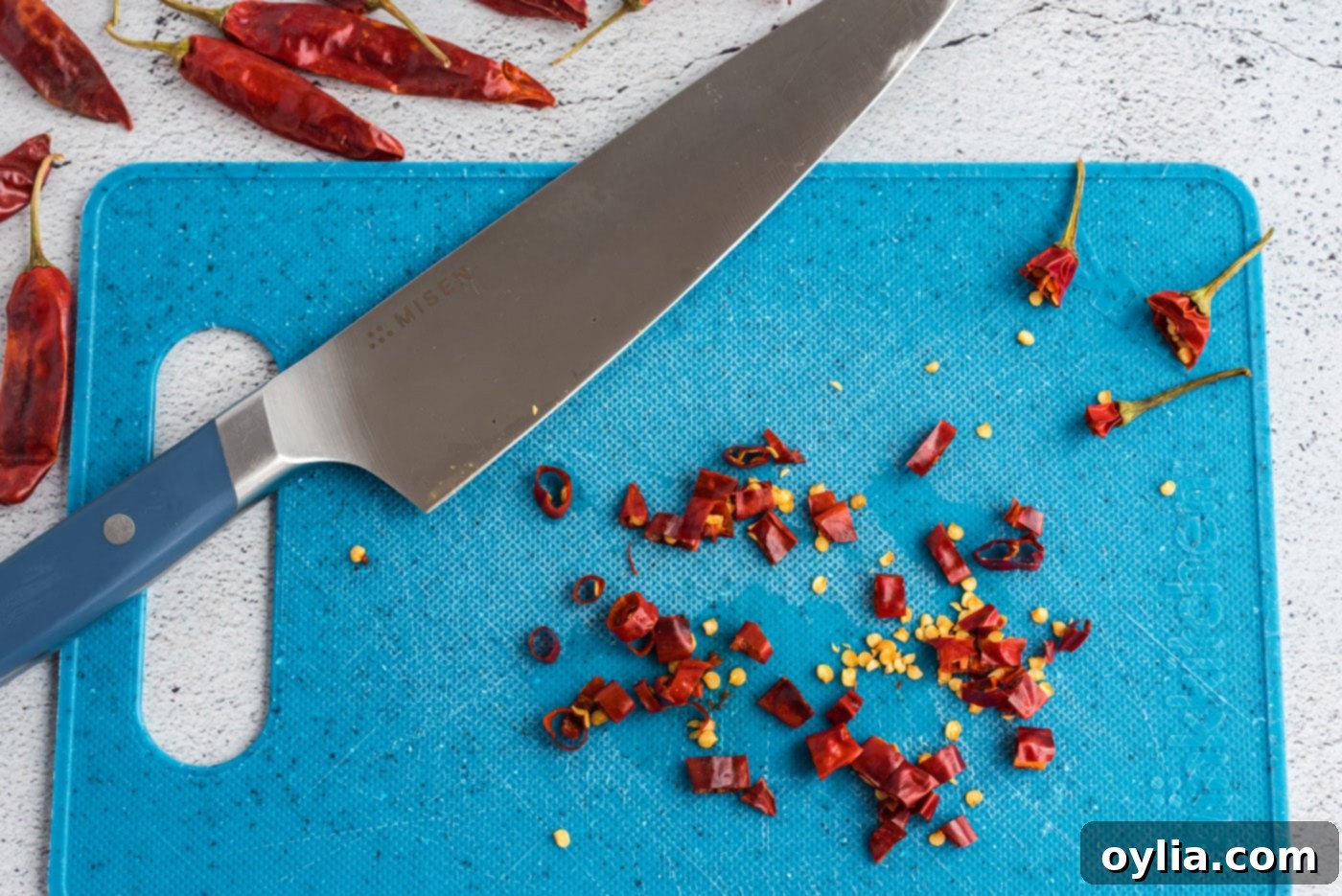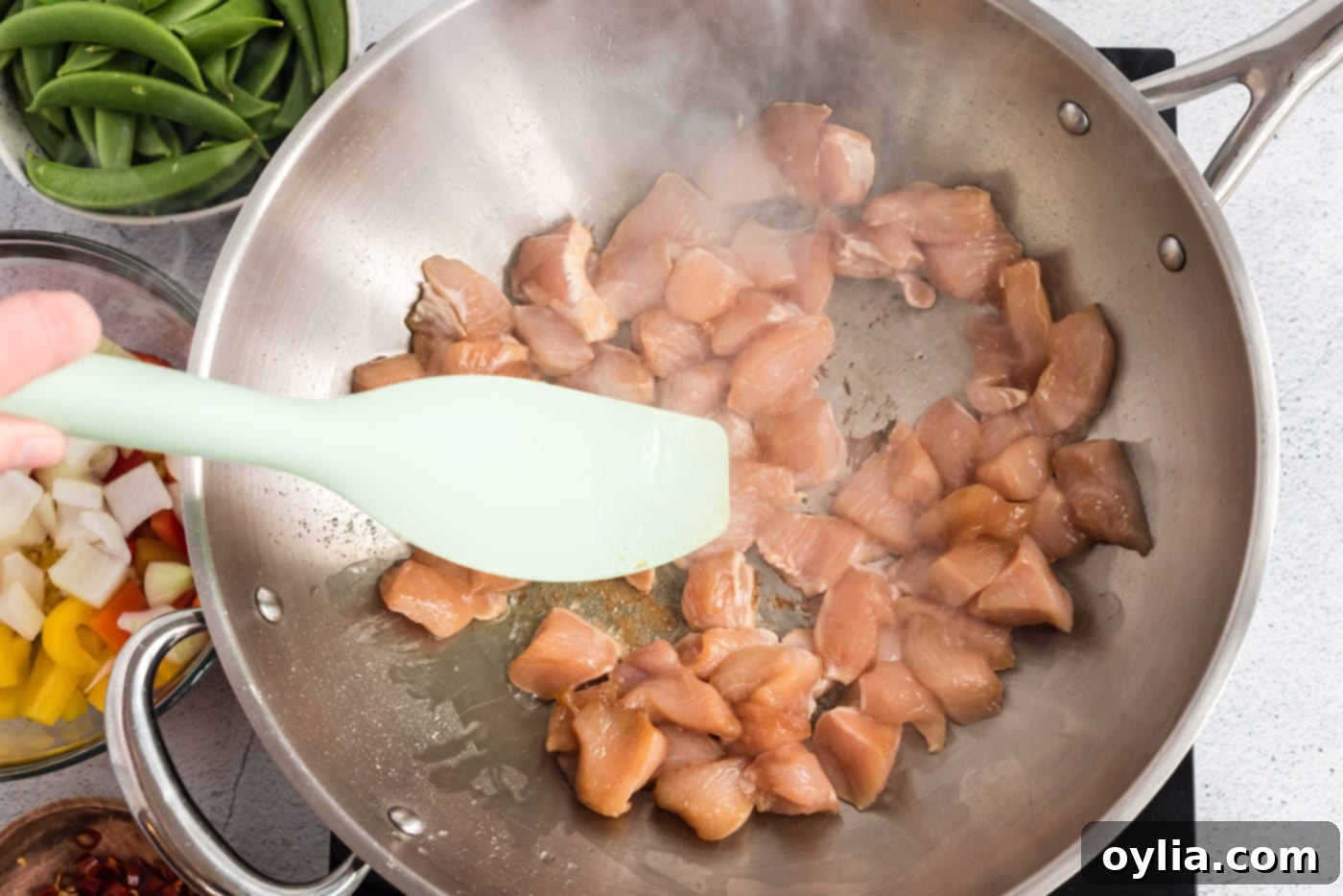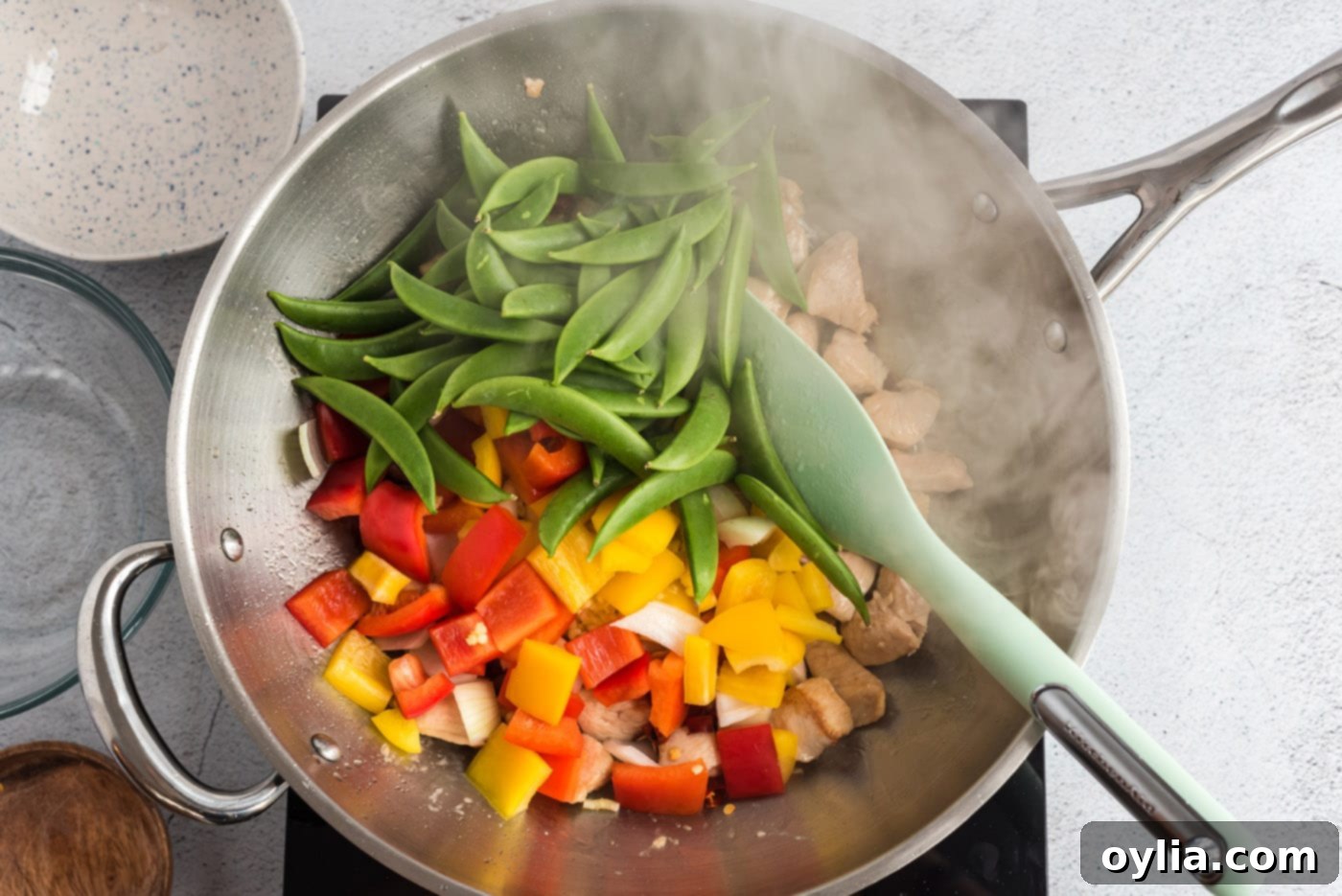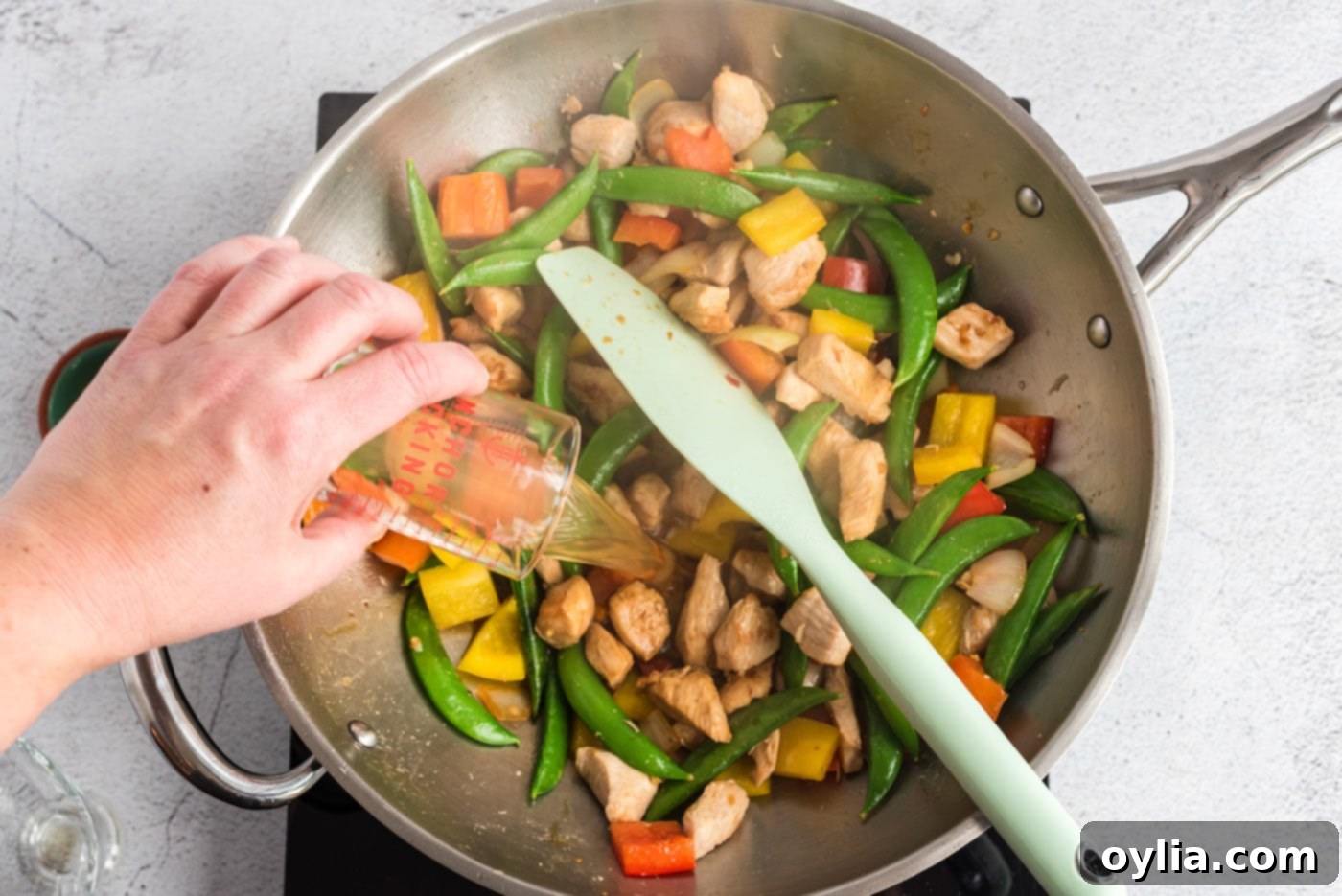Authentic & Healthier Kung Pao Chicken: Your Best Homemade Takeout Alternative
Craving the vibrant, spicy, and savory flavors of Kung Pao Chicken? This incredible recipe brings you tender chicken, crisp stir-fried vegetables, and a perfectly balanced sauce, all prepared in a healthier way right in your own kitchen. Forget the takeout menu – this homemade version is not only delicious but also better for you, allowing you to control the ingredients and achieve that restaurant-quality taste with fresh, wholesome components.
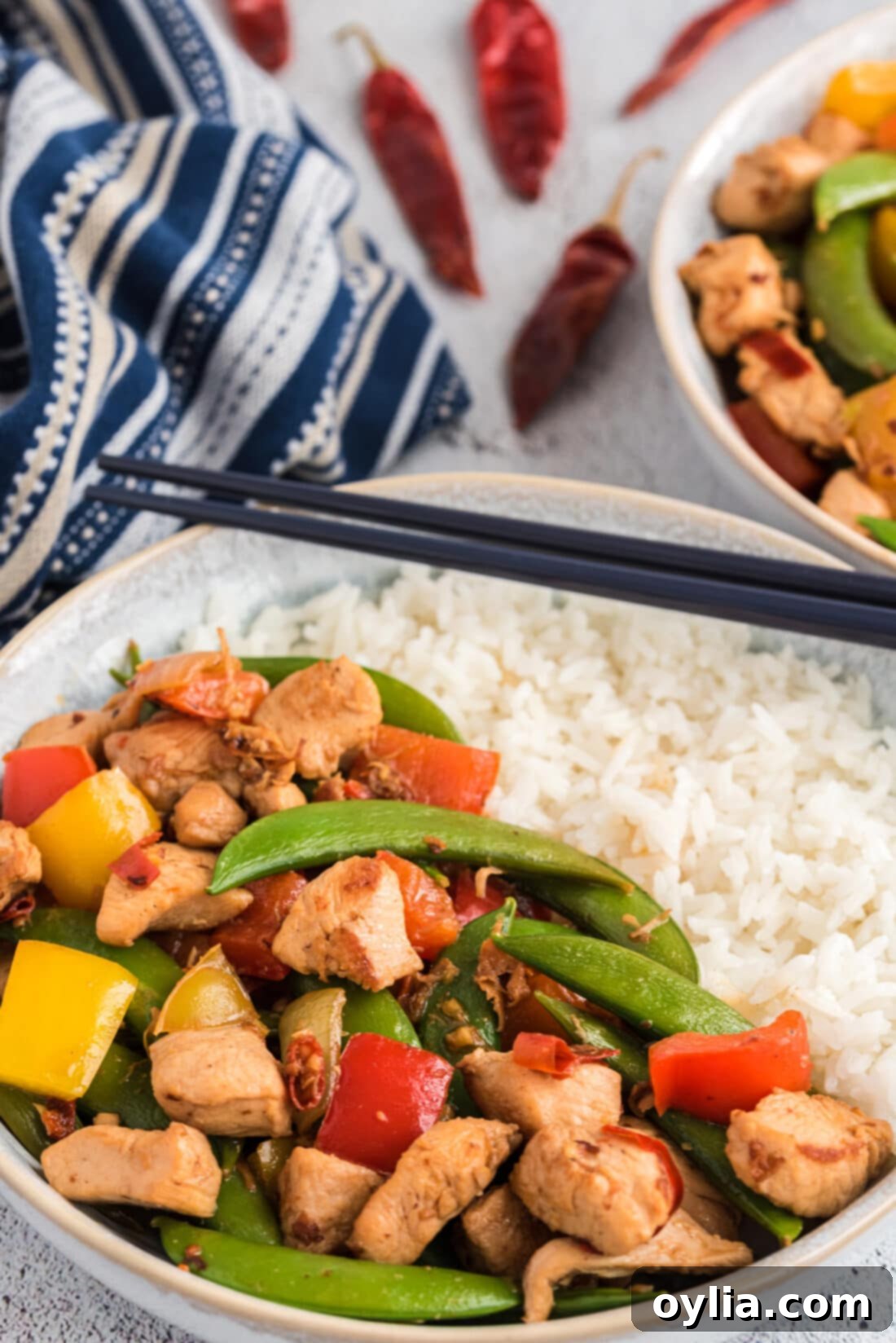
Why This Kung Pao Chicken Recipe Stands Out
If you’re a fan of flavorful stir-fries, Kung Pao Chicken undoubtedly holds a special place. This recipe is designed to exceed expectations, offering a culinary experience that’s both deeply satisfying and surprisingly wholesome. Unlike many restaurant versions that can be laden with excessive oil and sodium, our rendition prioritizes fresh ingredients and mindful preparation. By opting for low-sodium soy sauce and fat-free broth, we significantly reduce the unhealthy elements often found in store-bought or restaurant sauces, without compromising on the authentic, complex taste.
The magic of this recipe lies in its simplicity and the quality of its components. You gain complete control over the flavor profile, from adjusting the spice level to hand-picking the freshest vegetables. This means a dish free from artificial additives, excessive sugars, and unknown ingredients, resulting in a cleaner, brighter, and undeniably better meal for you and your family. It’s an accessible way to enjoy a beloved Chinese classic, transforming a typically indulgent takeout treat into a balanced and nutritious home-cooked delight.
RELATED: If you love quick and delicious chicken dishes, you might also enjoy our Chicken Chow Mein Casserole or a sweet and savory Bourbon Chicken recipe!
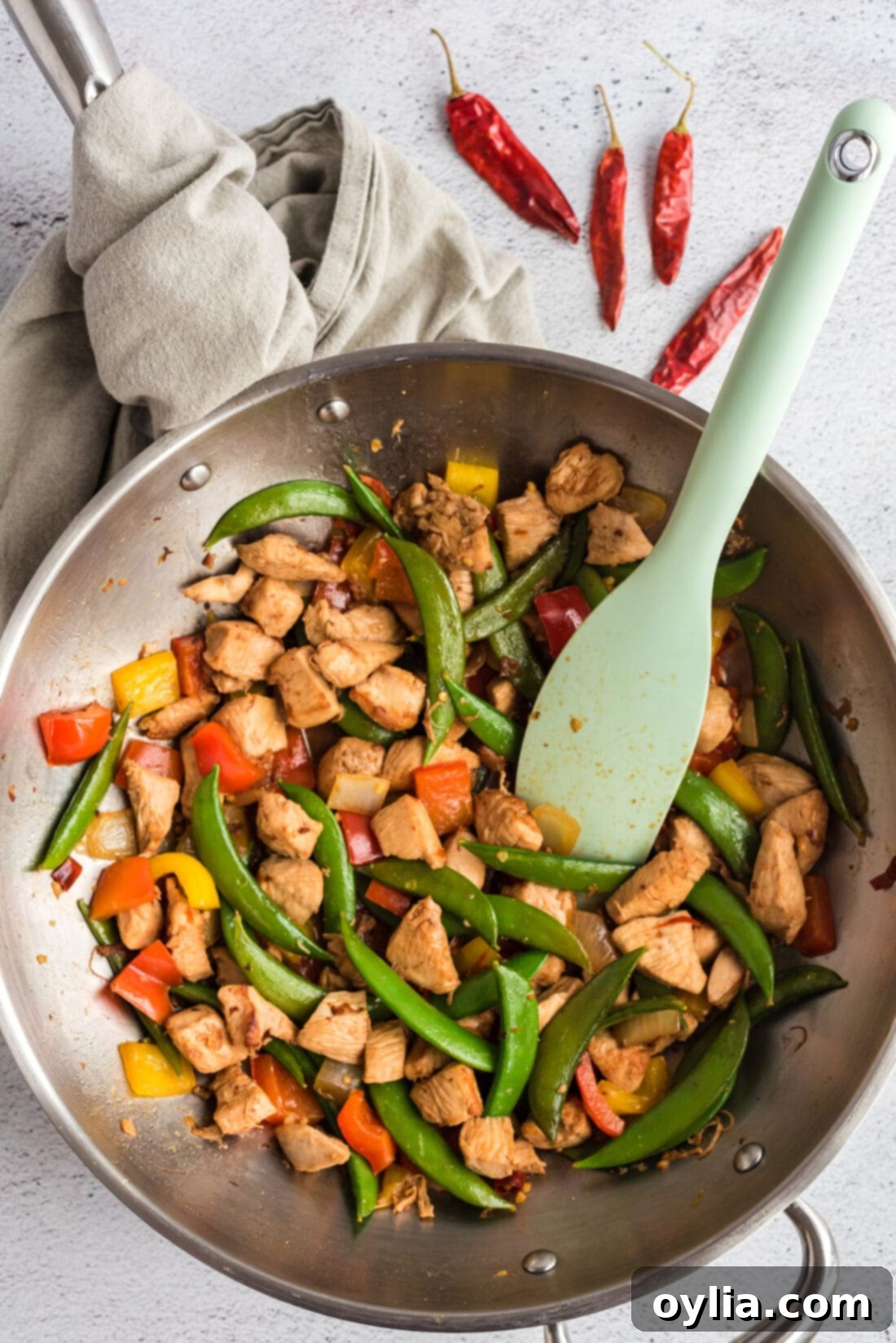
Key Ingredients for Your Homemade Kung Pao Chicken
To craft this exceptional Kung Pao Chicken, you’ll need a selection of fresh, high-quality ingredients. While the full list with precise measurements and detailed instructions is available in the printable version at the end of this post, let’s explore some of the stars of this dish. The beauty of cooking at home is selecting the best produce and proteins to elevate your meal. We’ll focus on vibrant bell peppers, sweet sugar snap peas, and succulent chicken, all brought together by a dynamic sauce base.
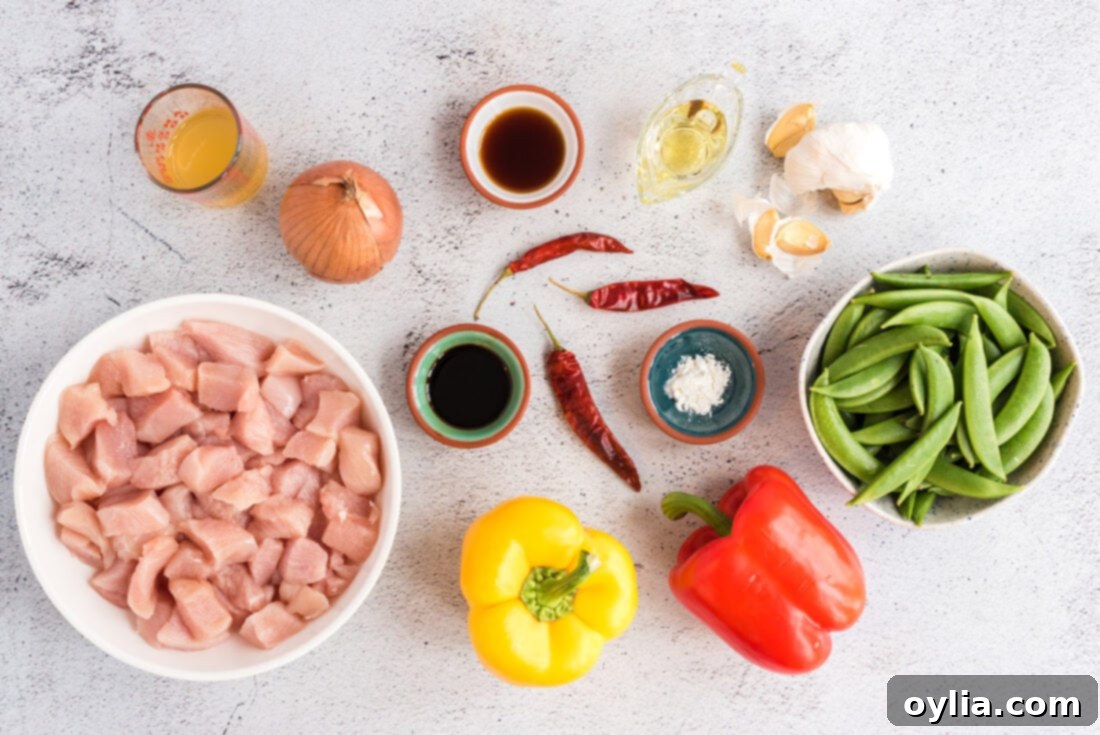
Ingredient Spotlight: Tips for Perfect Flavor and Texture
Understanding each ingredient’s role is key to mastering this dish. Here’s a closer look at the essential components and how you can tailor them to your preference:
CHICKEN – We recommend using boneless, skinless chicken breasts, cut into 1-inch chunks. This size ensures even cooking and perfect tenderness in every bite. While breasts are leaner, boneless, skinless chicken thighs can also be used for a slightly richer flavor and even juicier results. The initial marination with cornstarch and soy sauce is crucial for “velvetizing” the chicken, giving it that incredibly tender, silky texture characteristic of authentic Chinese stir-fries.
DRIED CHILI PEPPERS – The fiery heart of Kung Pao Chicken comes from dried red chiles. These aren’t just for heat; they also impart a distinctive smoky, robust flavor. You have full control over the spice level: for the spiciest possible rendition, keep all the seeds. For a milder, more approachable heat, simply remove and discard some or all of the seeds after soaking the chiles. Feel free to adjust based on your family’s preferences. If you’re looking to add an authentic numbing sensation (mala flavor), consider adding 1 to 1½ teaspoons of Sichuan peppercorns, traditionally used in Kung Pao for their unique citrusy and tingling effect.
SOY SAUCE – We specifically call for low-sodium soy sauce to keep this recipe healthier. Traditional soy sauce can be quite high in sodium, but a low-sodium option allows you to enjoy the deep umami flavor without overdoing the salt. If you only have regular soy sauce, you can use it, but you might want to reduce the total amount slightly. Light soy sauce is generally preferred for its color and saltiness without being too overpowering.
CORNSTARCH – This simple ingredient plays a dual role. First, it’s vital for marinating the chicken, creating a protective coating that locks in moisture and results in incredibly tender pieces. Second, it acts as a thickening agent for the sauce, giving it that desirable glossy, clingy texture that coats every piece of chicken and vegetable beautifully.
VEGETABLES – Our recipe features a vibrant mix of red and yellow bell peppers, onion, and crisp sugar snap peas, providing both color and crunch. The beauty of stir-fries is their versatility! Feel free to incorporate other quick-cooking vegetables you love, such as broccoli florets, carrots (thinly sliced), zucchini, or mushrooms. Ensure all vegetables are cut into uniform, bite-sized pieces to ensure even cooking.
BLACK VINEGAR – Also known as Chinkiang vinegar, black vinegar offers a complex, slightly sweet, and tangy flavor that is distinctively Chinese. If black vinegar is hard to find, a good substitute is white rice vinegar (or rice wine vinegar) for its similar acidity. Be aware that date vinegar or balsamic vinegar can also be used, but they are sweeter and will alter the flavor profile slightly, so add them judiciously and taste as you go.
BROTH – Using fat-free chicken or vegetable broth contributes flavor without adding unnecessary fats. It forms the liquid base of our sauce, melding with the soy sauce and vinegar to create the perfect savory-tangy balance.
GARLIC – Freshly minced garlic is indispensable in stir-fries, providing a pungent, aromatic foundation that builds the overall flavor profile of the dish. Don’t skip it!
OPTIONAL ADDITIONS (Nuts) – Many traditional Kung Pao recipes include roasted unsalted peanuts or cashews for added crunch and richness. If you enjoy this textural element, you can toss in about 1/4 to 1/2 cup of nuts during the final stages of stir-frying to allow them to warm through and meld with the sauce.
Step-by-Step Guide: Crafting Your Perfect Kung Pao Chicken
These step-by-step photos and detailed instructions are here to help you visualize how to make this recipe. You can Jump to Recipe to get the printable version of this recipe, complete with measurements and instructions at the bottom.
-
Begin by preparing your chicken. In a medium-sized bowl, combine the cornstarch with 1 teaspoon of the low-sodium soy sauce. Whisk them together until a smooth slurry forms. Add your 1-inch chicken chunks to this mixture, tossing thoroughly to ensure each piece is evenly coated. This marination step is crucial for achieving that signature tender, velvety texture in your chicken. Set the chicken aside to marinate for at least ten minutes, allowing the cornstarch and soy sauce to work their magic.


-
Next, prepare your dried red chiles. Soak them in hot water for several minutes. This rehydrates them and makes them easier to chop. Once softened, remove them from the water and chop them to your desired size. Remember, for a less spicy dish, you can discard some or all of the seeds. For a bolder, spicier flavor, leave some or all of the seeds intact. Use caution when handling chiles and wash your hands thoroughly afterward.


-
Now, it’s time to cook! Heat a large skillet or a wok over high heat until it’s very hot – this is crucial for stir-frying. Add the canola oil and swirl it around to coat the cooking surface. Once the oil shimmers, add the marinated chicken, spreading it out in a single layer if possible across the pan. Allow the chicken to sear on both sides until it’s lightly browned, which usually takes about 4 minutes. The goal here is not to cook the chicken all the way through, but to get a nice crust and seal in the juices. It will finish cooking with the vegetables and sauce.

-
Once the chicken is seared, add the prepared chiles, minced garlic, diced bell peppers (red and yellow), onion, and sugar snap peas to the pan. Stir fry these vibrant vegetables for several minutes, tossing frequently, until they become fragrant and slightly tender-crisp. This retains their fresh bite and bright color. Then, pour in the remaining one teaspoon of low-sodium soy sauce, along with the fat-free broth and black vinegar. Bring the mixture to a gentle simmer, then reduce the heat to medium-low. Allow everything to cook for another 2-3 minutes, stirring occasionally, until the chicken is thoroughly cooked through and the sauce has slightly thickened to coat the ingredients beautifully.


Frequently Asked Questions & Expert Tips for Perfect Kung Pao
Leftover Kung Pao Chicken is absolutely delicious the next day! Store any leftovers in an air-tight container in the refrigerator for up to 3-4 days. To reheat, simply place it in the microwave or a skillet over medium heat. If the sauce has thickened too much, add a dash of water or chicken broth to loosen it up and restore its ideal consistency. Avoid overcooking during reheating to maintain the tender texture of the chicken and crispness of the vegetables.
Black vinegar (Chinkiang vinegar) offers a unique, complex flavor profile that is slightly smoky and sweet with a pleasant tang. If you’re unable to find it at your local Asian market or specialty store, the best readily available substitute is white rice vinegar or rice wine vinegar, as it provides similar acidity. You could also experiment with a small amount of date vinegar or balsamic vinegar; however, keep in mind that these are typically sweeter, so start with a smaller quantity and adjust to taste to avoid making the dish too sweet.
Absolutely! The heat level in this dish is primarily controlled by the dried red chiles. For a spicier version, keep all the seeds in the chiles after soaking. For a milder flavor, remove and discard all or most of the seeds before chopping. You can also adjust the number of chiles used; more chiles equal more heat. For an extra kick and authentic numbing sensation, add 1 to 1½ teaspoons of Sichuan peppercorns with the chiles and garlic.
The versatility of stir-fries is one of their best features! While our recipe includes bell peppers, onion, and sugar snap peas, feel free to customize. Great additions include thinly sliced carrots, broccoli florets, zucchini, mushrooms, bamboo shoots, or water chestnuts for extra crunch. Just make sure to cut them into similar sizes for even cooking and add them to the pan at appropriate times, usually with the bell peppers.
Yes, many traditional Kung Pao Chicken recipes feature roasted, unsalted peanuts or cashews for a delightful crunch and nutty flavor. If you’d like to include them, add about 1/4 to 1/2 cup of your chosen nuts during step 4, when you add the vegetables and sauce. This allows them a few minutes in the hot pan to warm up and integrate their flavor with the other ingredients.
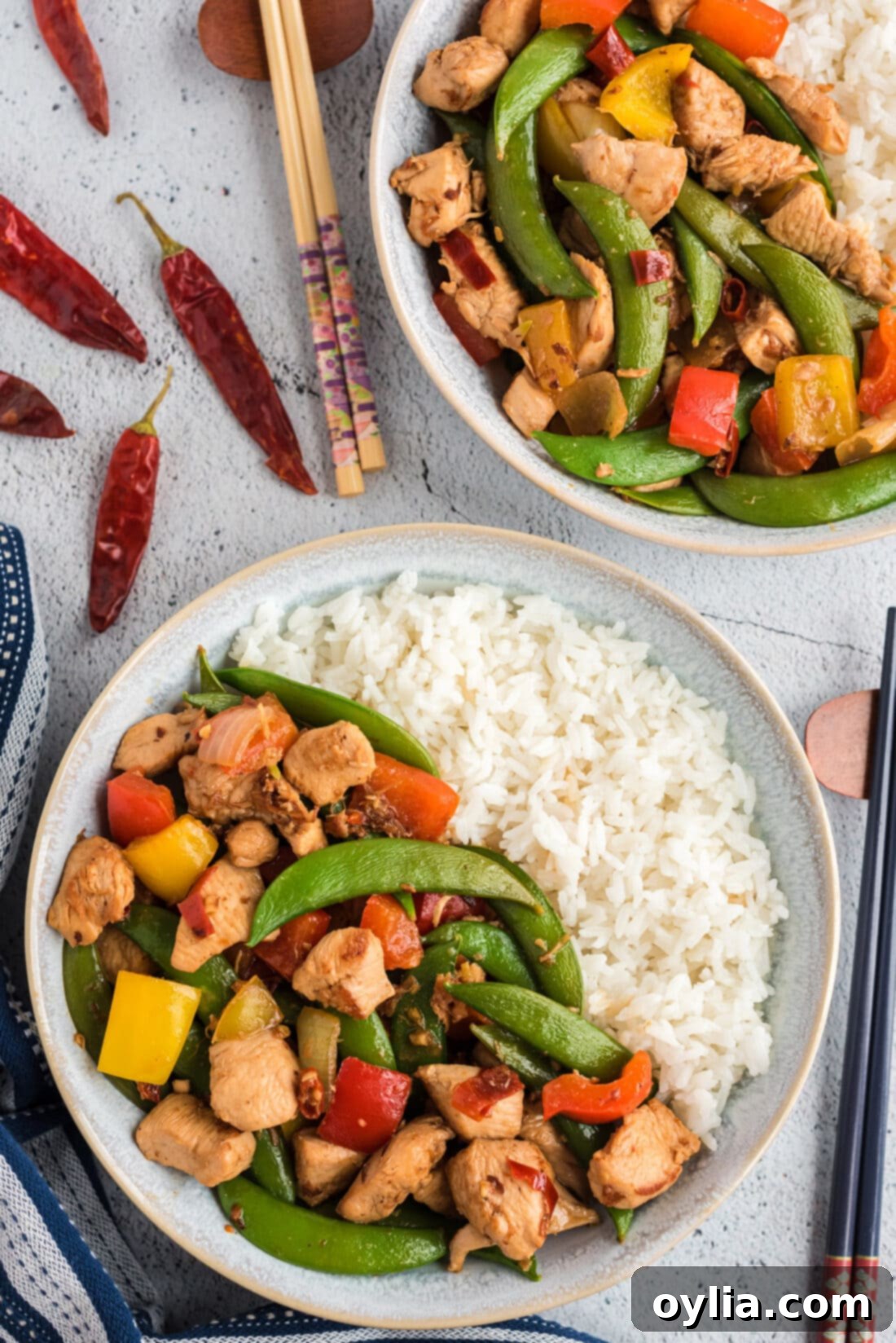
Perfect Pairings & Serving Suggestions
Kung Pao Chicken is a complete meal on its own, but it truly shines when served thoughtfully. The classic accompaniment, of course, is a fluffy bed of steamed white rice. The rice perfectly soaks up the savory and spicy sauce, creating a harmonious balance of flavors and textures. For a healthier option, consider brown rice or quinoa. If you prefer noodles, serving it alongside or on top of stir-fried noodles like lo mein or chow mein can also be a fantastic choice.
Beyond the main dish, a simple garnish can elevate the presentation and add an extra layer of freshness. A sprinkle of chopped green onions or a dash of sesame seeds adds both visual appeal and a subtle boost of flavor. As mentioned earlier, don’t hesitate to incorporate unsalted roasted peanuts or cashews into the stir-fry for an added crunch that many find essential to the authentic Kung Pao experience. This recipe, with its tender chicken and colorful medley of red and yellow bell peppers, onion, and sugar snap peas, offers incredible versatility. Feel free to experiment with different vegetable combinations based on seasonal availability and your personal preferences, making it truly your own custom-made takeout dish.
Explore More Delicious Stir-Fry Recipes
If you enjoyed this Kung Pao Chicken, you’ll love exploring other flavorful stir-fry dishes that bring the taste of Asia to your kitchen. Here are some of our favorites:
- Mongolian Beef – A sweet and savory beef stir-fry that’s always a crowd-pleaser.
- Sesame Chicken – Crispy chicken coated in a sticky, sweet, and nutty sesame sauce.
- Moo Goo Gai Pan – A lighter, wholesome chicken and vegetable stir-fry.
- Chinese Pepper Steak – Tender steak and bell peppers in a rich, savory sauce.
- Teriyaki Chicken and Rice – A classic Japanese-inspired dish, perfect for a quick meal.
- Szechuan Beef – For those who love bold, spicy flavors with tender beef.
- General Tso Chicken – A popular sweet and spicy deep-fried chicken dish.
I absolutely love to bake and cook, and sharing my kitchen experiences with all of you brings me so much joy! Remembering to come back each day for new recipes can be tough, which is why I offer a convenient newsletter every time a fresh recipe posts. Simply subscribe today and start receiving your free daily recipes directly in your inbox!
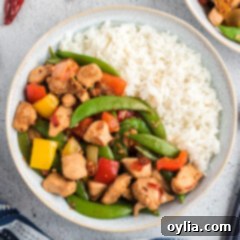
Kung Pao Chicken
IMPORTANT – There are often Frequently Asked Questions within the blog post that you may find helpful. Simply scroll back up to read them!
Print It
Pin It
Rate It
Save ItSaved!
Course:
Dinner
Cuisine:
Chinese
4 servings
133
Amanda Davis
Ingredients
- 10 ounces boneless skinless chicken breasts 2 breasts, cut into 1-inch chunks
- 2 teaspoons low-sodium soy sauce divided
- ½ teaspoon cornstarch
- 2-3 red dried chiles chopped (adjust for desired heat)
- 2 teaspoons canola oil
- 2 cloves garlic minced
- ½ red bell pepper cut into 1-inch dice
- ½ yellow bell pepper cut into 1-inch dice
- ½ small onion cut into 1-inch dice
- 1 ½ cups sugar snap peas
- 3 tablespoons fat free chicken vegetable broth
- 1 tablespoon black vinegar
Things You’ll Need
-
Large skillet or wok
-
Chef’s knife and cutting board
Chef’s Notes & Pro Tips
- You can add in 1/4-1/2 cup of unsalted roasted peanuts or cashews for extra crunch and nutty flavor. If adding nuts, toss them into the mixture during step 4, allowing them a few minutes in the pan to meld with the other flavors and warm through.
- For an authentic “mala” (numbing and spicy) flavor, consider adding about 1 to 1½ teaspoons of Sichuan peppercorns along with the dried chiles and garlic. Lightly toast them in the dry pan for a few seconds before adding oil, then proceed with the recipe.
- The heat from this dish comes primarily from the red chiles. You have complete control over how spicy yours is! For the spiciest version, keep all the chile seeds. For a milder recipe, remove them altogether. You can also vary the number of chiles used to fine-tune the temperature to your tastes.
- If black vinegar (Chinkiang vinegar) is unavailable, white rice vinegar or rice wine vinegar makes a good substitute. You could also try date vinegar or balsamic vinegar, but be mindful that these two kinds of vinegar are sweeter in taste and will alter the flavor slightly, so add them cautiously.
- For the best stir-fry results, ensure your skillet or wok is very hot before adding oil and ingredients. This high heat helps to sear the chicken quickly and cook the vegetables to a tender-crisp texture, preventing them from steaming.
Instructions
-
In a medium bowl, combine the cornstarch with 1 teaspoon of the low-sodium soy sauce. Add the chicken chunks and toss until every piece is evenly coated. Set this mixture aside to marinate for ten minutes; this step is essential for tenderizing the chicken.
-
Place the dried red chiles in a small bowl and cover them with hot water. Let them soak for several minutes until softened. Drain the water, then chop the chiles. For a milder dish, discard some or all of the seeds before chopping.
-
Heat a large skillet or wok over high heat until it’s very hot. Add the canola oil and swirl to coat the bottom and sides of the pan. Add the marinated chicken, spreading it out in a single layer. Sear the chicken on both sides until lightly browned, about 4 minutes in total. The chicken does not need to be cooked through at this stage.
-
Add the chopped chiles, minced garlic, diced bell peppers (red and yellow), onion, and sugar snap peas to the pan. Stir fry for several minutes until the vegetables are fragrant and tender-crisp. Pour in the remaining one teaspoon of soy sauce, the fat-free chicken broth, and the black vinegar. Bring the mixture to a simmer, then reduce the heat to medium-low. Continue to cook for 2-3 minutes, stirring occasionally, until the chicken is fully cooked through and the sauce has thickened slightly to coat all the ingredients. Serve immediately and enjoy!
Nutrition
The recipes on this blog are tested with a conventional gas oven and gas stovetop. It’s important to note that some ovens, especially as they age, can cook and bake inconsistently. Using an inexpensive oven thermometer can assure you that your oven is truly heating to the proper temperature. If you use a toaster oven or countertop oven, please keep in mind that they may not distribute heat the same as a conventional full sized oven and you may need to adjust your cooking/baking times. In the case of recipes made with a pressure cooker, air fryer, slow cooker, or other appliance, a link to the appliances we use is listed within each respective recipe. For baking recipes where measurements are given by weight, please note that results may not be the same if cups are used instead, and we can’t guarantee success with that method.
This post originally appeared here on June 23, 2013 and has since been updated with new photos and expert tips to enhance your cooking experience.
This recipe was slightly adapted from Jaden Hair’s new book Steamy Kitchen’s Healthy Asian Favorites: 100 Recipes That Are Fast, Fresh, and Simple Enough for Tonight’s Supper, a fantastic resource for delicious and healthy Asian cuisine.
